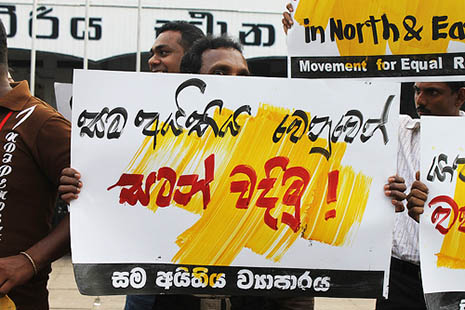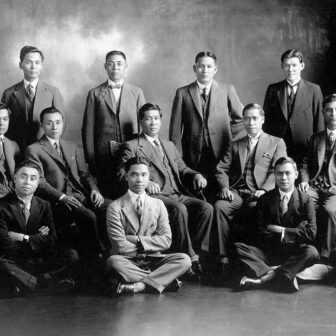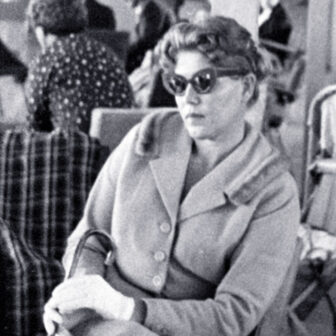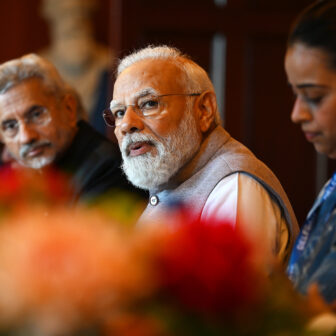BRAMI has rushed from work to meet me. She arrives on her bike and tells me she must be home soon to care for her three children. We sit down to talk in a small office in a village in Sri Lanka’s Northern Province, beneath the unforgiving glare of a bare light bulb. Very soon it is dark outside.
Brami, who is thirty-six but looks much younger, is quiet and well-dressed, and smiles frequently as we talk. Although she seems a little nervous, she wants to tell me about her experiences as a Sri Lankan Tamil, a widowed mother of three children, and a survivor of Sri Lanka’s three-decade civil war. She is also one of nearly 10,000 Sri Lankans who paid people smugglers to take them to Australia last year.
Sri Lankans have never before come to Australia by boat in such large numbers. Since January 2012, 8000 of them – including more than 1700 so far this year – have journeyed to Australia without passing through an official Sri Lankan port. In 2012, a record year for boat arrivals, Sri Lankans made up the biggest single national group for the first time. Even during 2009, at the end of Sri Lanka’s civil war, the numbers were significantly lower.
Both the Australian and Sri Lankan governments say that the surge is fuelled by “economic migrants,” but the evidence from migrants themselves reveals complex motivations, with economic concerns linked inextricably to political problems, persecution, and other forms of discrimination and injustice. These concerns are shared outside Sri Lanka: after a visit to Sri Lanka in August this year, the United Nations High Commissioner for Human Rights highlighted the impunity enjoyed by government forces, the failure of the rule of law and the fact that president Mahinda Rajapaksa’s government was “heading in an increasingly authoritarian direction… despite the opportunity provided by the end of the war to construct a new vibrant, all-embracing state.”
Over the past three years, Sri Lankan authorities claim to have caught around 4500 people trying to leave by boat. But reports suggest that parts of the Sri Lankan government are complicit in people-smuggling operations. Australia relies heavily on the Sri Lankan navy to combat people smuggling, but what if our partner is part of the problem in more ways than one?
SIX months before I met her, Brami paid a people smuggler to take her and her three children to Australia. Travelling with a group of people from her village, they were caught by Sri Lankan authorities and arrested.
When I asked Brami why she tried to leave, she told me that she was concerned for her children’s future and wanted to make sure they received a good education. She was also fearful of being home alone without her husband, who she later told me had been taken away five years earlier and not seen again. She described her concerns as “commonplace.”
But as our conversation continued, Brami disclosed that officers from the Sri Lankan Police Criminal Investigation Department, or CID, have visited every month since her husband disappeared. These men would “stay a short time if my children were there but longer if they weren’t,” she told me. “They would call me and ask to go somewhere, that kind of thing.” CID has her phone number and she gets “midnight calls” where they “talk rubbish.” “They know I’m alone so they are trying to get a benefit.”
Although Brami characterised herself as an economic migrant with the same everyday fears as many women in female-headed households, her words suggested that she also feared physical, and probably sexual, harm at the hands of police. It is difficult to imagine that her story is unique; she is one of an estimated 40,000 women living in female-headed households in the country’s former conflict zones. These are among the most highly militarised regions in the world, with an estimated one soldier for every five civilians. The UN High Commissioner recently highlighted her concern that women and girls in female-headed households are vulnerable sexual harassment and abuse, including at the hands of military personnel.
Kedish, a young Tamil man in the Vanni area of Sri Lanka’s Northern Province, also tried and failed to go to Australia to improve the financial situation of his family. His family was displaced frequently during the final phase of the war and then held in a refugee camp for nearly a year. Before the war, they had a paddy field, a house and vehicles, but when they returned they found just a few bushes and coconut trees; everything else had been destroyed in aerial attacks. “I want to go abroad to earn money for my family,” Kedish told me. “Earlier we were wealthy people and now I feel like poor people so I want to leave.”
Kedish now lives in a militarised area of the Northern Province under a tarpaulin, in fear of war returning. With large numbers of military officers in the area, he also fears for his sisters’ safety. “There is a narrow road to home and the military are on both sides. They tease women as they pass. In the evening the girls do not go out,” he said.
Not surprisingly, former cadres of the Liberation Tigers of Tamil Eelam, or LTTE, are also among the boat migrants. The Sri Lankan government says it has now “rehabilitated” 11,770 ex-cadres who surrendered to security forces at the end of the Sri Lankan civil war in 2009. In Sri Lanka’s case, rehabilitation involves detention without judicial oversight or legal representation, and monitoring by local security forces when ex-cadres return to their villages.
Some former combatants feel threatened and harassed by this monitoring, and by visits to their homes by security forces or requests to go to local military bases for questioning. They also report having difficulty getting loans or employment because of prejudice or fear in the community. The Jaffna High Court acknowledged earlier this year that private firms are reluctant to employ rehabilitated former LTTE cadres and that banks are reluctant to provide them loans. This discrimination leads to economic disadvantage, the court said, and causes people to leave the country illegally in search of a better future.
Parathis, a young former LTTE combatant in the Eastern Province, told me he had tried to leave for Australia because of poor employment opportunities. He had been forcibly recruited as a boy and lost years of schooling in service to the LTTE, but he had not fought during the final stages of the war or been “rehabilitated.” He was about to graduate from university, but he was not a confident student and he believed his prospects were limited.
Parathis had no immediate security concerns, but he believed that war could break out again because the government had done nothing to address the grievances of Tamils. He worried that his past association with the LTTE meant that he would be the first to be blamed and targeted if war came. “So far [I have] no problem with the army, but a bit of concern if war comes that we will be subjected to torture,” he told me. Only Sinhalese people get job opportunities in police and military services, he believes, and even the unskilled workers on development projects in the Eastern Province come from other communities.
For other people I met, it was the unchecked operations of pro-government paramilitary organisations that drove them to flee. Aingkaran, a bicycle repairman in the Northern Province, was intercepted en route to Australia by Sri Lankan authorities. He initially cited economic pressures for leaving, particularly the difficulty of bringing up girls and finding dowries after the death of an uncle who had been a source of financial support. But he had also been forced to give money to “unknown people” after he was threatened by phone, and on one occasion a grenade was thrown into his home, killing his dogs and damaging the property. Despite reporting these incidents to the police, he has had no news of an investigation.
Aingkaran’s experience illustrates the wider problem of impunity and a breakdown in the rule of law – problems that extend to the failure of the Sri Lankan government to investigate allegations of war crimes at the end of the civil war and the unconstitutional impeachment of the chief justice, Shirani Bandaranayake, in January this year.
A striking feature of the tone of many of my discussions with Sri Lankans who have tried or would like to leave was their feeling that circumstances were unlikely to improve. Four years after the war, many Tamil people had no expectation of peace or safety in the Northern Province. “I’ve lost all hope that I can have a life here; there is no guarantee for life here,” one man said. “It is better to go to other countries so that I can live peacefully.”
IT IS a violation of Sri Lankan law to leave the country other than through an official port. If boat migrants are caught by Sri Lankan authorities they are detained and charged with illegal migration under Sri Lankan law, or with people smuggling offences if they organise the boats or are members of the crew.
Australia works very closely with Sri Lankan authorities on anti-people-smuggling operations inside Sri Lanka. Since 2009, and perhaps for longer, Australian Federal Police officers have worked in Sri Lanka to support authorities’ efforts in this area. Australian officials share intelligence and provide training and resources to the Sri Lankan police, navy and coast guard.
Despite these significant commitments by Australia, and massive increases in the budget of the Sri Lankan defence ministry, nearly 6500 people slipped through Sri Lanka Navy’s net in 2012 and only around 3000 were caught. The sheer scale of the boat migration and the openness with which agents and sub-agents operate in the villages raise questions about the role of Sri Lankan authorities.
In February this year, the Australian alleged that a “senior Sri Lankan government official was complicit in people smuggling” and was effectively undermining the joint attempts to stop boats in Sri Lanka. Australia’s intelligence agencies had identified a “high profile” official “close to Sri Lankan president Mahinda Rajapaksa” who has “the power to ‘turn on the tap’ and unleash untold asylum boats.” According to a subsequent article, Australian officials had considered whether the surge in boat migrants to Australia was retaliation by Sri Lankan officials for Australia’s co-sponsorship of a March 2012 UN resolution that called for Sri Lanka to investigate allegations of war crimes committed in 2009.
The Australian government denied having seen evidence of this corruption and Sri Lanka said that there was no truth to the allegations. But in September 2013, the Sri Lankan government was embarrassed by the arrest of four of its officers in relation to allegations that they were involved in people smuggling.
Among people who are trying to leave Sri Lanka on boats there is a widespread belief that the navy and the government either operate the smuggling or condone it, and that this is what makes safe passage possible. As one man in the Northern Province told me, “Last year people didn’t know about the boats but now the agents are starting to function better. This year the military is supporting the operations.”
Some Tamil people believe that the government is involved in the smuggling because it wants them to leave. “In prison in Negombo, the police told me that I should go to Australia,” a Tamil man caught en route to Australia told me. “I think the government wants the young people to go… Those who leave from here are all Tamils – the military are more concerned to catch the Sinhalese. I think they want the Tamils to go abroad,” he said.
With “stopping the boats” now the objective of the bilateral relationship with Sri Lanka, it has become increasingly difficult for Australia to engage critically on human rights issues. The possibility that the Sri Lankan government is involved in organising boats creates a double bind: Australia is forced to cooperate with an unreliable partner in the knowledge that if it displeases Sri Lanka there is a potential for many more asylum boats to arrive. Human rights violations go unchallenged and Australia continues to provide Sri Lanka with intelligence taken from immigration detainees and increased military aid.
In October last year, Australia made a strong statement to the United Nations Human Rights Council outlining concerns about uninvestigated abductions and disappearances in Sri Lanka, and about torture and mistreatment by police and security forces. But since then criticism of Sri Lanka’s human rights record has been muted. Australia made no public statement of concern after the impeachment of chief justice Shirani Bandaranayake in January, despite many like-minded countries and international organisations expressing their concern at the threat it posed to an already compromised rule of law in Sri Lanka.
When the United States sought co-sponsors for another Human Rights Council resolution in March 2013 calling for investigation of Sri Lankan war crimes, Australia only announced its decision to co-sponsor at the eleventh hour. It was widely recognised that Australia was attempting to balance competing interests by avoiding making a statement critical of the Sri Lankan government in the Human Rights Council chamber.
In May this year, after a long hiatus, Australia’s foreign minister at the time, Bob Carr, indicated that he had raised human rights with the Sri Lankan government. While he acknowledged that “media and civil society continue to operate in a difficult environment” and said he had raised concerns about the impeachment of the chief justice, Australia continues to downplay evidence of human rights abuses in Sri Lanka.
The outlook for change is bleak. After a five-day visit to Sri Lanka in January 2013, two senior Coalition figures – Julie Bishop, now foreign minister, and Scott Morrison, now immigration minister – praised the reconciliation and reconstruction efforts of the Sri Lankan government and said that they saw no evidence of ongoing human rights abuses. Australia’s new government has committed to using the Australian navy to turn all boats back to Sri Lanka without doing any form of assessment of the passengers’ claims for asylum.
For Brami and others in Sri Lanka, meanwhile, the military occupation of Tamil-majority areas continues and their lives are coloured by economic, political and physical insecurity. Only 1700 Sri Lankans have arrived by boat so far this year, but there is no end in sight to the factors that drive the attempts to leave. •




